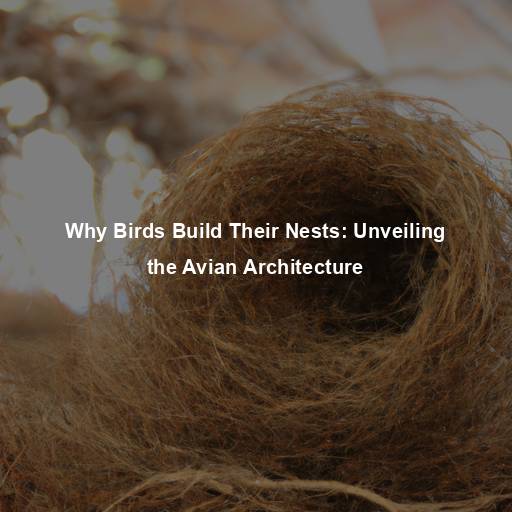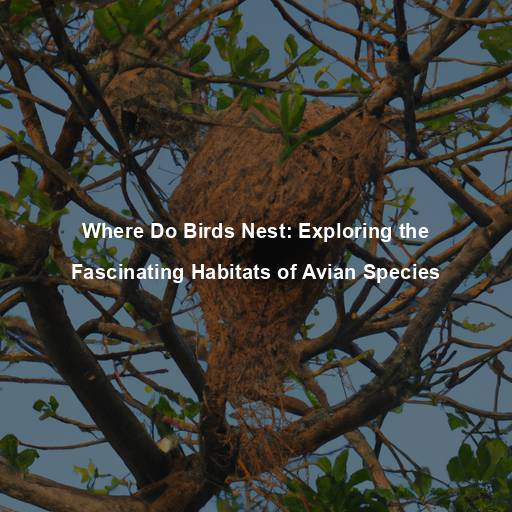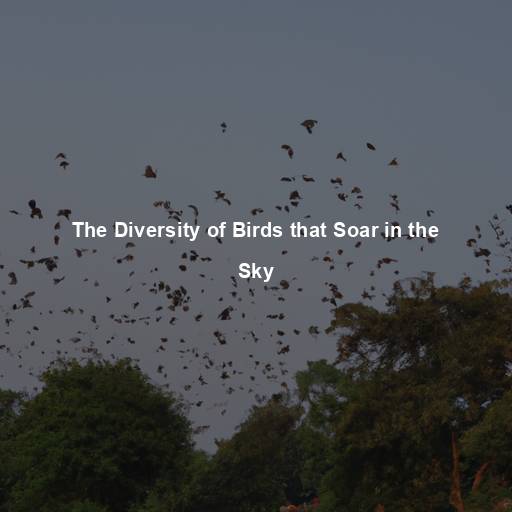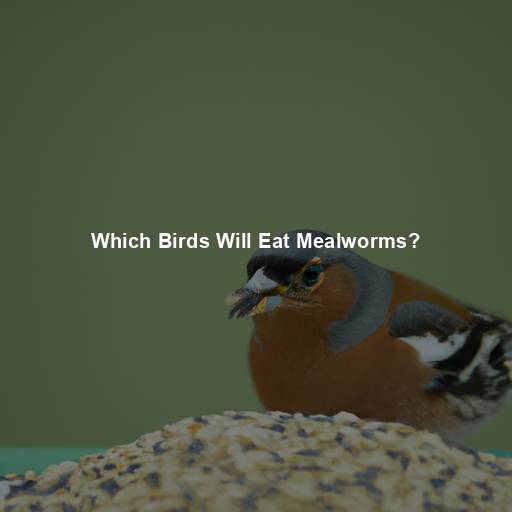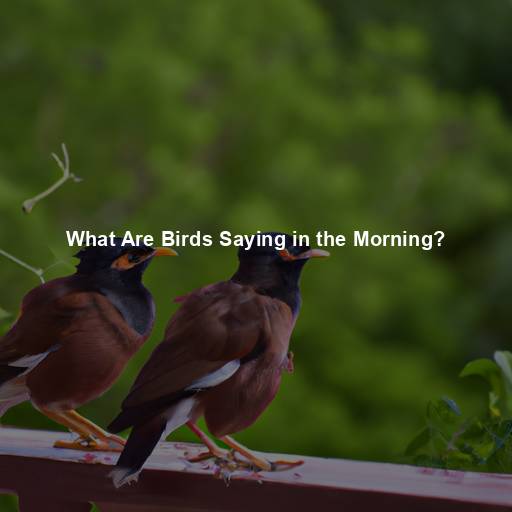Why Birds Build Their Nests: Unveiling the Avian Architecture
Last Updated on July 10, 2023 by Evan
Contents [hide]
- 1 The Fascinating World of Bird Nests
- 2 The Wonder of Avian Architecture
- 3 Nest Building Challenges
- 4 The Evolutionary Significance of Nest Building
- 5 The Intricacies of Nest Site Selection
- 6 The Wonders of Avian Architecture: A Testament to Nature’s Ingenuity
- 7 Nest Predation and Strategies for Protection
- 8 The Cycle of Nest-Building
- 9 The Ethical Considerations of Nest Observation
- 10 FAQs – Why Birds Build Their Nests
- 10.1 Why do birds build nests?
- 10.2 What materials do birds use to build their nests?
- 10.3 How do birds construct their nests?
- 10.4 Where do birds build their nests?
- 10.5 Do all birds build nests?
- 10.6 Can birds reuse their nests?
- 10.7 How long do birds use their nests?
- 10.8 Are there any benefits to birds building nests in human-made structures?
The Fascinating World of Bird Nests
Birds, with their vibrant feathers and enchanting melodies, have captivated human hearts for centuries. Beyond their beauty and song, these creatures possess an extraordinary skill: nest-building. Have you ever wondered why birds build nests? What drives them to invest time and energy in constructing these intricate structures?
The Purpose of Bird Nests
Bird nests serve as more than mere shelters for our feathered friends. They play a vital role in the reproduction and survival of avian species. Nests provide a safe haven for eggs and vulnerable hatchlings, shielding them from predators, harsh weather conditions, and other potential threats. Additionally, nests serve as cozy nurseries, offering warmth, protection, and an ideal environment for the growth and development of young birds.
The Diversity of Nest Designs
The world of birds never ceases to amaze with its bewildering array of nest designs, each crafted with utmost precision to cater to their specific needs and surroundings. It’s as if these avian engineers possess an innate understanding of architecture and construction. Some utilize the age-old technique of weaving together twigs, leaves, and grass, creating a solid oasis for their young. Meanwhile, others employ a more unconventional approach, carving out burrows in diverse habitats like tree trunks, cliffs, or even the very ground beneath our feet.
Evolutionary Adaptations
Throughout the ages, the marvel of nest-building has traversed the tapestry of time. Like a symphony of ingenuity, birds have gracefully embraced the artistry of secure abodes, evolving their talents with each new terrain they conquered. Morphological adaptations, like bill shapes or dainty feet, emerged as the vivacious avian architects meticulously tailored their skills to gather materials and construct bespoke habitats. With each flutter of feathers, the astounding culmination of this intricate dance reveals itself in a tapestry of perplexing yet captivating diversity.
Environmental Influences
Birds are quite the architectural marvels when it comes to building their nests. These feathered architects possess an incredible ability to adapt their nest designs to the diverse environments they call home. Whether it’s the towering trees of a lush forest, the rugged cliffs along a coastal region, or the vast open spaces of grasslands, birds ingeniously construct their nests to thrive in their surroundings. The choice of materials, from twigs and leaves to delicate feathers and even spider silk, adds another intriguing layer to their construction techniques.
Nesting Strategies and Techniques
Birds are true architects of the natural world, displaying an astonishing array of nesting techniques that leave us in awe. From the lone rangers who meticulously construct their own private havens, to the gregarious penguins who congregate in bustling neighborhoods, bird society is never devoid of excitement. Yet, it doesn’t stop there. For a select few, the notion of cooperative living takes flight, as multiple individuals come together to collaboratively build and tend to a shared nest.
Innate vs. Learned Behavior
Nest-building in birds is a remarkable combination of innate instincts and learned behavior. While the basic blueprint for nest construction is often genetically encoded, birds also learn from their parents and observe other members of their species. Juvenile birds acquire valuable skills and techniques by watching experienced nest builders, ensuring the continuity and refinement of nest-building traditions across generations.
Cultural Variations
It’s absolutely fascinating how diverse our world is – not just in terms of human cultures, but also in the animal kingdom. Take birds, for example. Did you know that they have their own unique cultures when it comes to building nests? It’s mind-boggling!
The Wonder of Avian Architecture
Bird nests are not only marvels of engineering but also windows into the world of avian life. They provide us with invaluable insights into the evolutionary adaptations, environmental influences, and social dynamics of these incredible creatures. As we continue to explore and appreciate the wonders of bird nests, let us marvel at the intricate structures that symbolize the unwavering dedication, resilience, and creativity of our feathered friends. ## The Role of Nest Appearance
Camouflage and Concealment
The ingenious nature of bird nests goes beyond mere construction; it encompasses a delicate dance between survival and adaptation. Each unique species has masterfully evolved to create nests that effortlessly meld into their surroundings, a true marvel of natural engineering. By harmonizing colors and textures with the environment, these birds defy expectation, effectively safeguarding their precious eggs and nestlings from the ever-watchful gaze of predators. This symbiotic relationship between camouflage and reproduction highlights the intricate balance that nature so intricately weaves.
Signaling and Attractiveness
Every bird has its own unique nesting style, some preferring to blend into the surroundings while others prefer to make a statement. These bold and eye-catching nests are not only visually striking, but also serve an important purpose in the avian world. The vibrant colors, intricate designs, and even the addition of decorative objects like flowers or feathers all contribute to the nest builder’s goal of attracting a mate or establishing territory. By showcasing their creativity and resourcefulness through these visually stunning nests, birds are able to communicate their strength, health, and ability to provide for future offspring.
Nest Building Challenges
Resource Acquisition
Constructing a nest requires gathering and transporting suitable materials from the surrounding environment. Birds must locate and collect twigs, leaves, grass, mud, or other materials depending on their nest-building style. This process can be time-consuming and energy-intensive, particularly for birds that construct large or elaborate nests. Some species have developed specialized foraging techniques or even employ cooperative behaviors to streamline the resource acquisition process.
Construction Skills and Techniques
Building a sturdy and secure nest requires not only the right materials but also skillful construction techniques. Birds must have an innate understanding of how to weave, stack, and shape the collected materials to create a stable structure. The ability to interlock twigs, weave grasses, or use sticky substances to bind materials together is essential. Young birds learn these techniques through observation, practice, and trial-and-error, honing their skills over time.
Nest Maintenance
Once a nest is constructed, it requires regular maintenance to ensure its integrity and functionality. Birds may need to repair damaged sections, reinforce weak spots, or remove debris that accumulates over time. Maintenance tasks can include replacing broken twigs, reinforcing the nest lining, or removing parasites or old nesting materials. The dedication and effort birds invest in maintaining their nests contribute to the overall success and longevity of their breeding efforts.
The Evolutionary Significance of Nest Building
Nest Building and Reproductive Success
The ability to build a suitable nest is closely tied to a bird’s reproductive success. Nests provide a protected environment for eggs and nestlings, shielding them from predators, extreme weather conditions, and other potential hazards. A well-constructed nest increases the chances of eggs hatching successfully and ensures the survival of young birds during their most vulnerable stages of life. Natural selection favors individuals with strong nest-building instincts and skills, as they are more likely to pass on their genes to future generations.
Nest Building as a Display of Fitness
Birds, those feathered architects of nature, have a remarkable secret woven into their nest-building rituals. It turns out that their meticulous craftsmanship goes beyond simply creating a cozy abode for their young. In fact, the art of nest construction doubles as a captivating form of courtship. Like a dance of genetic prowess, birds flaunt their intricate nests as a means to attract potential mates.
The Intricacies of Nest Site Selection
Protection from Predators
The exquisite art of nest building is not solely based on aesthetics, but rather on the primal instinct to avoid becoming a fowl creature’s easy meal. In a dance of survival, birds meticulously scout for locations that provide a natural shield against potential predators. They stealthily create their abodes, nestled within lush thickets, cocooned in the secretive hollows of trees, or perched daringly on precipices, thus defying the talons of any would-be assailant. By choosing these fortresses of safety, avian parents bolster their progeny’s likelihood of flourishing into independent custodians of the skies.
Competition and Territory
Nest site availability can be limited, leading to intense competition among birds for prime nesting spots. Some species establish and defend territories that encompass suitable nesting sites. Intricate displays of aggression, vocalizations, and physical confrontations often occur between rival birds vying for the same area. The ability to secure a desirable nest site can significantly impact an individual bird’s reproductive success and social standing within the population.
The Wonders of Avian Architecture: A Testament to Nature’s Ingenuity
When it comes to bird nests, it’s hard not to be awestruck by the sheer artistry and problem-solving prowess that goes into their creation. These avian architects employ a dizzying array of designs, each tailored to their own specific needs and circumstances. From the meticulous construction processes to the strategic selection of nesting sites, every little detail speaks volumes about the evolution and adaptation of these remarkable creatures. Exploring the captivating journey of nest-building not only sheds light on the wonders of avian architecture, but also unveils the interconnectedness of ecology and evolution in the natural world.
As we embrace the mysteries surrounding the architectural wonders crafted by our avian companions, we are captivated by the enigmatic motivations driving their intricate nest-building endeavors. Each nest becomes an intricate tapestry of survival and ingenuity, showcasing the undeniable significance of these structures in the intricate tapestry of nature’s grand design. So, let us not overlook the profound impact that parental care has on the resilience and fortitude of birds, as they dedicate their tireless efforts to create havens of nurturing for their offspring. In the presence of a bird’s nest, let us succumb to awe and admiration for the unyielding bonds forged between these winged creatures and the environments they call home.
Incubation and Brooding
Once the intricate task of building a nest is completed by these fascinating creatures, their journey is not yet complete. The captivating process of incubation takes center stage, as it involves the delicate act of keeping the precious eggs snug and cozy until they are ready to hatch. What truly astonishes is the cooperative effort displayed by many bird species, as they take turns in nurturing the eggs, allowing each parent a well-deserved break. This companion-filled dance ensures that the soon-to-be-born birds experience a consistent and optimal environment for their growth.
Feeding and Provisioning
When it comes to raising their little ones, parent birds take on the ultimate role of providers. With unwavering determination, they embark on epic quests to find nourishment, spanning great distances through the skies. Each species has its own unique menu for their hungry nestlings, ranging from a delectable feast of insects, worms, seeds, fruits, or even a splash of fish. These dedicated parents make countless trips to their nests, delivering pre-digested meals that fuel the growth and development of their precious offspring.
Nest Sanitation
Creating a safe and cozy environment for their little ones is of utmost importance for bird parents. They go the extra mile to keep their nests spick and span, clearing away any waste or leftover food that could attract unwanted bacteria or pests. In fact, some bird species take it to the next level by incorporating aromatic plants or insect-repellent materials in their nests, creating a protective barrier against parasites. By diligently maintaining cleanliness, these dedicated bird parents ensure that their precious offspring thrive and flourish in the best possible way.
Nest Predation and Strategies for Protection
The Threat of Nest Predators
Despite their best efforts, birds face numerous challenges when it comes to protecting their nests from predators. Nest predation is a significant risk that can result in the loss of eggs or nestlings. Predators such as snakes, raccoons, squirrels, and other birds may target nests to obtain a meal or eliminate potential competitors. Nest predation can have a profound impact on bird populations, shaping their reproductive success and influencing population dynamics.
Nest Concealment and Camouflage
To minimize the risk of predation, bird species have evolved various strategies to conceal their nests. Choosing nest sites that provide natural cover, such as dense vegetation or well-hidden crevices, can make it harder for predators to detect and access the nests. Additionally, some birds employ camouflage techniques, using materials that match their surroundings to blend in seamlessly. By reducing the visibility of their nests, birds increase the chances of evading detection by potential predators.
Nest Defense and Distraction Displays
When it comes to protecting their precious nests and adorable offspring, parent birds unveil an astonishing array of defensive maneuvers. From fierce puffs of feathers and alarm calls that can send shivers down the spine, to courageously launching physical attacks, avian parents pull out all the stops. But wait, there’s more! Some clever birds employ the art of deception, performing elaborate distraction displays that would make even the most seasoned Hollywood actor jealous.
Synchronized Nesting and Predator Satiation
In the fascinating world of avian behavior, there exists a perplexing phenomenon known as synchronized nesting strategies. This clever tactic employed by certain bird species aims to counter the dreaded menace of nest predation. By gathering in large groups or colonies, these savvy birds create an overwhelming burst of nests, designed to bewilder and confound any would-be predators, decreasing the chances of any particular nest becoming a target. Moreover, some bird species take it a step further and practice the beguiling concept of “predator satiation”.
The Cycle of Nest-Building
Nest Reuse and Renovation
It’s truly mesmerizing to witness the intricate behaviors of our avian friends. Take a moment to ponder the fascinating phenomenon of nest reuse and renovation. Yes, that’s right! Many bird species, in a burst of ingenuity, choose to return year after year to the very same nest site.
Nest Parasitism and Brood Parasites
In the fascinating realm of avian reproduction, a peculiar phenomenon has captured the attention of researchers and bird enthusiasts alike: nest parasitism. While the majority of birds dutifully construct and tend to their own nests, an intriguing subset of species has adopted a more cunning strategy. Enter the brood parasites – the renegades of the avian world. With the infamous cuckoos leading the pack, these avian rebels forgo the laborious task of building their own nests and instead deposit their eggs in the unsuspecting abodes of other bird species.
The Ethical Considerations of Nest Observation
Balancing Conservation and Observation
Exploring the intricate world of bird nests opens a captivating door to understanding avian behavior, ecology, and the urgency of conservation efforts. Yet, venturing into this realm demands utmost ethical caution. Any untoward disturbance or mishandling of eggs risks perilously tipping the delicate scales of nesting activities, potentially casting a shadow on the birds’ well-being and their vulnerable offspring. Therefore, it becomes paramount for both researchers and avid bird enthusiasts to place the preservation of these feathered beings at the forefront of their nest observation studies, ensuring the sustainable flourishing of these remarkable avian species.
Respecting Nesting Sites
When it comes to giving nesting sites a little R-E-S-P-E-C-T, it’s all about keeping our distance and letting nature do its thing. Getting up close and personal might seem tempting, but trust me when I say that disturbing the bird’s hangout is a major no-no. So remember, follow the signs and give these feathered friends the space they need to raise their chicks in peace.
Citizen Science and Nest Monitoring
Citizen science initiatives have emerged as a powerful tool for monitoring bird nests and collecting valuable data. By involving the public in nest monitoring projects, researchers can gather information on nesting success, breeding behavior, and population trends. Engaging in responsible citizen science allows individuals to contribute to scientific knowledge while minimizing disturbance to nesting birds.
FAQs – Why Birds Build Their Nests
Why do birds build nests?
When it comes to avian abodes, nests are the epitome of ingenuity and foresight. These intricate structures serve as fortresses against predators and Mother Nature’s whims, safeguarding the precious progeny of our feathered friends. Beyond mere shelter, the artful creation of nests becomes a symbolic expression of avian sovereignty, marking their territory with architectural prowess. From the burst of activity to the perplexing precision, nest-building is a mesmerizing testament to nature’s wisdom.
What materials do birds use to build their nests?
The materials used by birds to build their nests vary based on the species and the availability of resources in their habitat. Common nest-building materials include twigs, grass, leaves, moss, feathers, and even man-made items like bits of plastic or string. Some birds, such as the weaver bird, are famous for their intricate and elaborate nests built using grass, leaves, and thin strips of plant material.
How do birds construct their nests?
Birds use a variety of techniques and strategies to construct their nests. Some species weave intricate structures by interlocking and intertwining materials, while others create simple depressions on the ground or in tree cavities. Birds often use their beaks to shape and position the materials and may also use their feet to compact the nest. The construction process can take hours to several days, depending on the complexity of the nest and the bird’s skill.
Where do birds build their nests?
Birds, those marvelous creatures of the sky, have an inexplicable talent for creating homes in the most unpredictable places. From the grounded abodes to the elevated sanctuaries, and everything in between, their nest-building prowess leaves even the most astute observers delightfully perplexed. Whether perched amidst the branches of towering trees or hidden within the depths of shrubbery, each avian architect has its own peculiar preference. Some crave the rugged allure of cliffs, while others seek solace in the nooks and crannies of man-made structures. Ah, the enigmatic nesting habits of our feathered friends, forever shrouded in a veil of fruitful mystery.
Do all birds build nests?
Not all birds build nests. Some species, known as cavity nesters, prefer to lay their eggs and raise their young in pre-existing cavities, such as tree hollows or abandoned burrows. These birds do not construct nests but instead use materials like feathers, leaves, or moss to line the cavity and create a suitable environment for their eggs and chicks.
Can birds reuse their nests?
Birds, fascinating beings of the sky, never cease to amaze us with their ingenious ways. It turns out that many of these feathered friends are not only skilled craftsmen but also keen recyclers. Just like us, some migratory bird species have a soft spot for nostalgia and opt to return to their previous nesting sites, breathing new life into their humble abodes. By reusing these nests, they effortlessly save precious time and energy, sparing themselves the construction hustle and focusing solely on minor upgrades. However, it’s essential to remember that not all avian creatures follow this eco-friendly trend; some prefer to embark on a grand quest for creating a fresh, tailor-made nest each breeding season. What a marvelously perplexing display of individuality!
How long do birds use their nests?
Birds, in their unpredictable avian ways, exhibit a fascinating range of nest usage patterns. From regal eagles to stately storks, these majestic creatures meticulously refurbish and dwell in their nests for extended periods, lasting for several years. However, their smaller counterparts, the passerine birds, known for their delicate nature, opt for a more transient approach, utilizing their nests exclusively for a single breeding season. Following the departure of their fledglings or the unfortunate failure of their precious eggs, these resilient birds naturally relinquish their nests, perhaps anticipating the opportunity to construct new abodes for future nesting endeavors.
Are there any benefits to birds building nests in human-made structures?
Yes, there are benefits to birds building nests in human-made structures, such as buildings or birdhouses. These structures can provide readily available nesting sites in areas where natural nesting locations are limited or destroyed. The presence of bird nests near human habitations can also offer opportunities for birdwatching and create a sense of coexistence between humans and birds. However, it is important to consider the welfare of the birds when providing man-made nest options, ensuring they are suitable and do not cause harm or disturbance.

